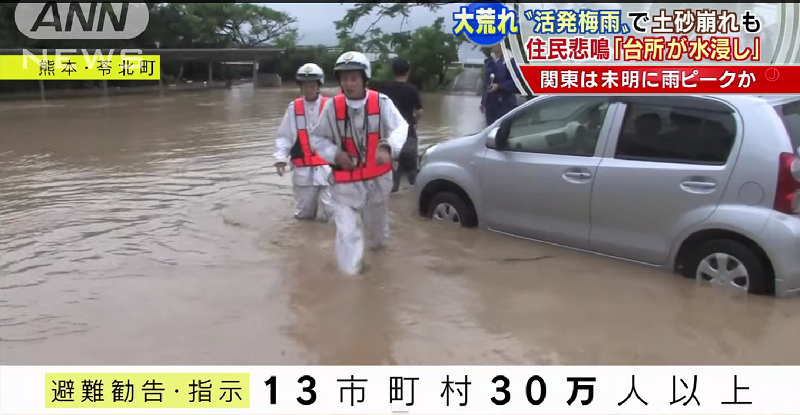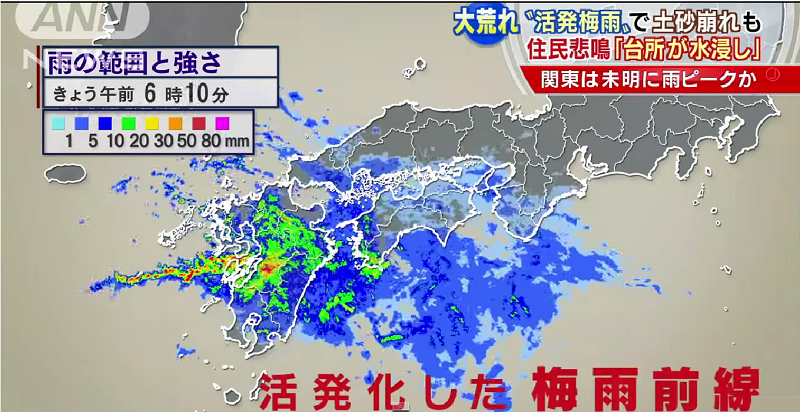
Caption: [KUMAMOTO] More than 30,000 people evacuated from 13 municipalities (in Kyushu). Screencap: ANN official YouTube Channel
Look at the Equatorial Pacific, Gulf of Alaska, Arctic Ocean: this is what a strong El Niño looks like. pic.twitter.com/swumagsJgP
— Peter Gleick (@PeterGleick) June 12, 2015
For Japan this can mean cooler temperatures in early summer:
日本では、冷夏や暖冬になりやすくなります。具体的には、夏は低温、多雨、日照時間が少なくなる傾向があります
As a result of El Nino, Japan will experience a cooler than normal summer and a warm winter. Summers will feature cool temperatures and heavy rain, with fewer than normal sunny days. Source.
Japan experienced its hottest month of May on record, with many regions across Japan reaching temperatures in the mid-30's — temperatures not normally seen before mid-summer.
天気ニュースアップしました。ぜひご覧ください。 天気ニュース – 記録的高温 エルニーニョが影響 – Yahoo!天気・災害 http://t.co/QggiaPS1Ig @Yahoo_weatherさんから pic.twitter.com/TY6XkMDzm3
— 気象予報士 河津真人 (@makotokawazu) May 27, 2015
I've uploaded the weather forecast – please take a look. “Return of El Nino causes record temperatures across Japan (in May 2015)” – Makoto Kawazu, Meteorologist at TBS Weather Map
As of mid-June, while the Japan Meteorological Agency is predicting normal temperatures for much of Japan, there should be higher than normal amounts of rainfall for the island of Kyushu in the southwest. The rest of Japan will probably experience lower than normal amounts of precipitation for June and July.
This is because the El Nino phenomenon is influencing the traditional “rainy season” weather pattern the Japanese archipelago experiences each June and July. The weather pattern, known as tsuyu, or the the baiu zensen, typically begins in late May in Okinawa and the far southwest of Japan.
The rain front gradually travels north from east to west, dousing the entire archipelago in rain in June and early July. The predictability of the rainy season and the progression of the rain front has played a key role in Japanese rice cultivation for more than two thousand years.
This year the baiu rain front has remained stuck over the island of Kyushu in southwest Japan, refusing to budge, hammering the island with heavy rains. Kumamoto and Nagasaki prefectures, located midway up the island have been hit especially hard, with some regions receiving 50 to 80 millimetres of rain every hour.

Caption: Increasingly active baiu zensen. Screencap from ANN official YouTube channel.
The steep mountainous terrain of much of Kyushu has turned the runoff from all of this rainfall into raging cataracts that are overflowing onto city streets and causing mudslides. So far more than 30,000 people have been evacuated due to flooding and landslides.
The torrential rains are providing spectacular television footage:
Kumamoto, which lies on the western slope of steep, high hills that are right in the path of rainclouds, is dealing with serious flooding:
【熊本県内の天草市や八代市などで大雨、道路冠水や浸水】 http://t.co/TuXFfBkTio 活発な前線の影響で、西日本の広範囲で大気の状態が不安定となっており熊本県や長崎県では局地的に非常に激しい雨が降っている。 pic.twitter.com/euA2AbbPqk
— 日刊時事ニュース (@nikkan_jijinews) June 11, 2015
[The cities of Amakusa and Yashiro are experiencing heavy flooding.] http://t.co/TuXFfBkTio
Due to an extremely active baiu rain front, a large area of western Japan is experiencing unsettled weather. Kumamoto and Nagasaki prefectures are receiving exceptionally heavy rainfall. – JiJi Nikkan News Service.
Besides the threat of natural disasters such as flooding and devastating landslides, a cooler summer in Japan thanks to El Nino will likely result in poor agricultural production. For Japanese consumers, this means higher prices at the supermarket:
やはり今年の夏野菜は高騰しそうだな
— かも カモ (@c_a_m_o_) June 11, 2015
It looks like vegetables are going to suddenly cost a whole lot more this summer.
県内、野菜値上がり/レタス、先月の3倍に | 香川のニュース | 四国新聞社 http://t.co/4F8QhcciMW らりるれレタスも http://t.co/e451UHLZtq 影響受けているんかなぁ?
— 詠み人知らず (@yomi_bito) June 7, 2015
I wonder if our own Rarirureru Lettuce is going to be affected??? [NOTE: Kagawa Prefecture on the southern island of Shikoku is an agricultural powerhouse providing high-quality produce throughout Japan.]
- “In Kagawa Prefecture the price of a head of lettuce has tripled since last month. | Kagagawa News | Shikoku Shimbun”
While natural calamities are nothing new in Japan, recent years have seen increasingly wild weather. Last summer torrential rains caused a massive landslide in Hiroshima Prefecture that killed 74 people in one neighborhood.
広島市の土砂災害で亡くなられた方のご冥福と、早期の復興をお祈りします。 pic.twitter.com/K4dzPDFYa3
— 美酒乱三世_みちのく一人旅 (@bishuran3rd) August 22, 2014
We pray that the victims of the [2014] Hiroshima landslides enjoy peace in the next world, and that there will be a quick start to reconstruction.






